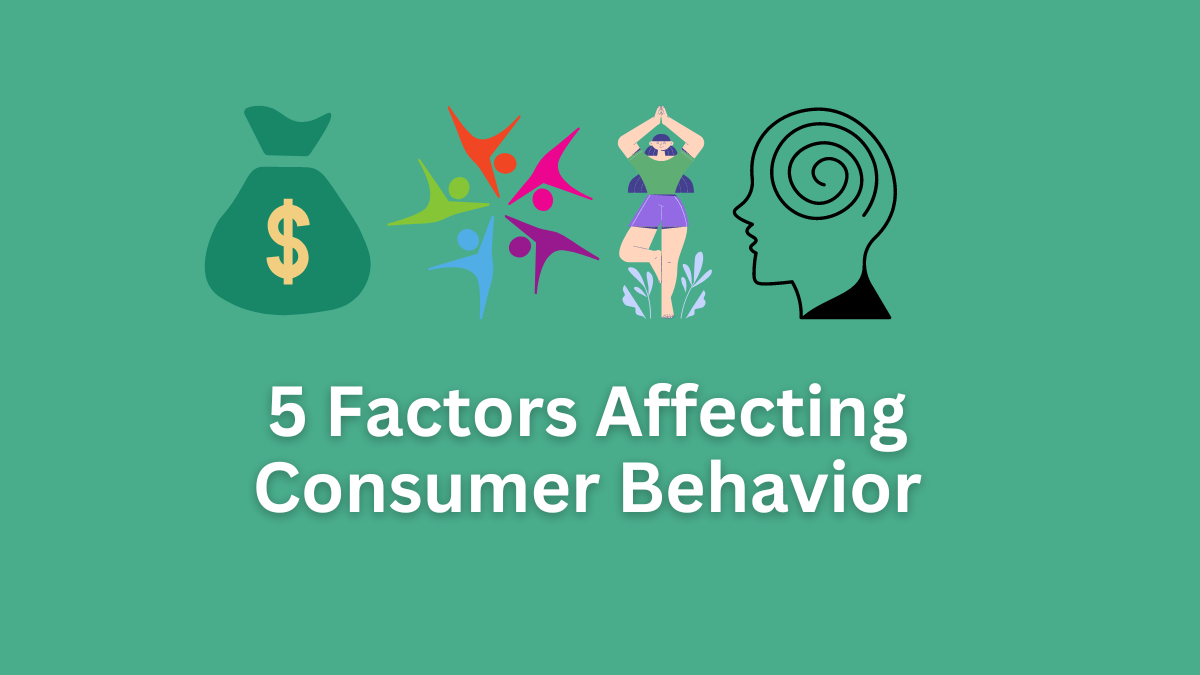Factors Affecting Consumer Behavior
Consumer Behavior refers to the actions and decisions consumers show while buying products and services. It is influenced by various factors.
Do you know why your and your friends buying behavior is different? In this article, we are going to discuss this. Let’s explore the 5 key factors influencing consumer behavior.
Economic Factors
Definition: Economic factors affecting consumer buying behavior are all about how much money people have and how confident they feel about spending it. It’s like a financial tug-of-war that affects what and how much we buy.
Economic factors greatly affect how consumers shop. These factors stem from a person’s financial situation and the state of the economy around them.
Factors: Several things come into play here. Firstly, personal income – how much cash you’ve got in your pocket. If it’s bulging, you’re more likely to buy more stuff. Family income matters too; if more family members are earning, there’s more to spend.
Read More: Buyer Behavior – Definition
Access to credit, like credit cards, can encourage spending. Also, liquid assets, which means things like cash in your wallet or money in your bank account – having more makes you feel comfortable spending. And finally, savings – if you’re saving a lot, you might not spend much.
Impact: When times are good, with a strong economy and people earning more, they’re more confident to spend on various items. In a weaker economy with less income and job uncertainty, people tend to cut back on spending, especially on non-essential items. So, these economic factors are like a financial thermostat that can turn up or down how much and what we buy.
Psychological Factors
Definition: Psychological factors affecting consumer buying behavior dive into the thoughts and feelings that guide our buying choices. It’s like peeking into our minds to understand why we buy what we buy.
Factors: There are four key mental forces at play. First, there’s motivation – it’s what pushes us to buy, whether it’s satisfying our basic needs or fulfilling a desire. Second, perception – this is how we see products, influenced by things like ads and reviews.
Then, there’s learning – how we pick up info about products through experience. Lastly, attitudes and beliefs – our opinions and feelings towards a product, which can be shaped by previous experiences.
Read More: 4 Types of Consumer Behavior
Impact: These factors can change what we put in our shopping carts. If we’re highly motivated and see a product as satisfying our needs, we’re more likely to buy it. A good perception of a product can make us want it, and past experiences can persuade our choices. Our attitudes and beliefs about a product can also be deal-breakers.
Social Factors
Definition: Social factors affecting consumer buying behavior are like the invisible hands of our friends, family, and society, guiding our shopping choices without us even realizing it. They’re the influences of the people and groups we’re connected to.
Factors: There are three major players in this social game. First, our families – they shape what we like and what we’re used to buying. Then, there are our reference groups – the folks we hang out with – they influence what we pick from the store shelves. Lastly, our social status – where we stand in society – can make us spend differently.
Read More: Market Research – Definition
Impact: Imagine your friend raving about a cool gadget; you might want it too. If your family prefers a certain brand of coffee; you’ll likely buy the same. And if you’re in a fancy job, you might lean towards high-end products to match your status. So, these social factors urge us toward certain purchases, making them a big deal in the shopping world.
Cultural Factors
Definition: Cultural factors influencing consumer buying behavior are like unwritten shopping rules shaped by our backgrounds and communities. They’re the invisible hands that guide our choices.
Factors: Three main players here. First, there’s culture itself – the traditions, values, and beliefs we inherit from our society. Then, subculture – smaller groups within the big culture with their own quirks. Lastly, social class – where we stand in society, based on income, education, and job.
Impact: Think of cultural factors as the secret recipe for your shopping cart. If your culture values thriftiness, you might be a bargain hunter. Subculture can add a twist – like being a tech geek in a family of artists. And social class can decide whether you go for a designer or a discount.
Read More: PESTLE Analysis – Definition
Personal Factors
Definition: Personal factors affecting consumer buying behavior are like the ingredients that make your buying choices unique. They’re the peculiarities that set you apart from others.
Factors: Four key players here. First, age – whether you’re a teenager, adult, or senior can change your shopping list. Second, income – how much money you have to spend matters a lot. Third, occupation – your job shapes your shopping patterns. Lastly, lifestyle – your habits and interests, like being a fitness freak or a bookworm.
Impact: Imagine personal factors as the secret sauce in your shopping recipe. Your age might mean you’re into video games or gardening. Your income decides if you dine at fancy restaurants or fast food joints. Your job can make you pick office wear or casual outfits. Your lifestyle makes you reach for gym gear or cooking utensils.
Read Next: Types of Consumer Needs
Arti Kushmi holds a BBS (Bachelor in Business Studies) degree and shares her business and marketing knowledge through this website. While not writing she will be reading and enjoying the moment.
